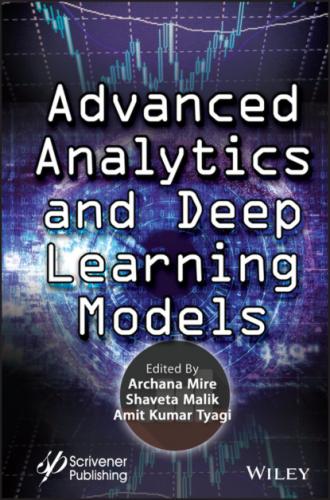8 Index
9 Wiley End User License Agreement
List of Table
1 Chapter 2Table 2.1 Columns of dataset.Table 2.2 Different evaluation metrics.Table 2.3 Comparison of algorithm.
2 Chapter 3Table 3.1 Dataset statistics.Table 3.2 Result comparison.Table 3.3 Dataset.Table 3.4 Comparison among clustering and non-clustering approach.Table 3.5 Comparison among existing methods in MCRS.
3 Chapter 4Table 4.1 Comparison of DL and ML.
4 Chapter 6Table 6.1 Literature review of existing technological works on Alzheimer’s disea...
5 Chapter 7Table 7.1 Model prediction accuracy.Table 7.2 Comparison between RCNN variants.Table 7.3 Comparison between Markov decision model and Q learning model.
6 Chapter 8Table 8.1 Percentage-wise usage of machine learning algorithms.
7 Chapter 9Table 9.1 Comparison on commonly utilized deep learning models [2].Table 9.2 Comparison of various algorithms on detection of AD.Table 9.3 Comparison of various algorithms on detection of Parkinson’s disease.Table 9.4 Results of the algorithm on detection of attacks on deep brain stimula...
8 Chapter 12Table 12.1 Comparison of 2018 vs. 2019 data security [1].Table 12.2 Data breach from February to June 2020 [1].
List of Figures
1 Chapter 1Figure 1.1 Chatbot responding to the user contextually.Figure 1.2 Chatbot responding to the user contextually.
2 Chapter 2Figure 2.1 Flow of work.Figure 2.2 Missing values.Figure 2.3 Visualizing missing values using heatmap.Figure 2.4 Different BHK attribute.Figure 2.5 Bath visualization.Figure 2.6 BHK visualization.Figure 2.7 Scatter plot for 2 and 3 BHK flat for total square feet.Figure 2.8 Scatter plot for 2 And 3 BHK flat for total square feet after removin...
3 Chapter 3Figure 3.1 Working principle of MCRS.Figure 3.2 Phases of MCRS.Figure 3.3 Filtering techniques of MCRS.Figure 3.4 Result comparison.Figure 3.5 Experimental result.Figure 3.6 Result.
4 Chapter 4Figure 4.1 Advancement of artificial intelligence.Figure 4.2 AI, ML, and DL.Figure 4.3 Working network of deep learning.Figure 4.4 Difference between ML and DL.Figure 4.5 Types of ML.Figure 4.6 Supervised learning algorithm.Figure 4.7 Unsupervised learning algorithm.Figure 4.8 Reinforcement algorithm.Figure 4.9 Supervised, unsupervised, and reinforcement learning.Figure 4.10 Regression algorithms.Figure 4.11 Instance-based algorithms.Figure 4.12 Regularization algorithms.Figure 4.13 Decision algorithms.Figure 4.14 Bayesian algorithms.Figure 4.15 Clustering algorithms.Figure 4.16 Association rule learning algorithms.Figure 4.17 Artificial neural network algorithms.Figure 4.18 Deep learning algorithms.Figure 4.19 Dimensional reduction algorithms.Figure 4.20 Ensemble algorithms.Figure 4.21 Convolutional Neural Networks.Figure 4.22 How our DL algorithm sees an image.Figure 4.23 Convolution layers.Figure 4.24 DL terminology examples.Figure 4.25 Neural network.Figure 4.26 AI or real Shakespeare?Figure 4.27 GAN.Figure 4.28 GAN examples.Figure 4.29 GAN example.Figure 4.30 GAN used to create painting.Figure 4.31 AI in chatbots.Figure 4.32 Behavior of the sentiment neuron. Colors show the type of sentiment.Figure 4.33 Flowchart of the methodology.Figure 4.34 Flowchart includes training and testing.Figure 4.35 Values of the trained dataset matrices.Figure 4.36 Values of the tested datasets matrices.Figure 4.37 Sample cervical cancer magnetic resonance image (MRI).Figure 4.38 Loading the MRI image from datasets.Figure 4.39 Contrast enhancement.Figure 4.40 Image segmentation.Figure 4.41 Segmented region of interest (ROI).Figure 4.42 After classification, cervical cancer (ROI) tumor is found.Figure 4.43 After classification, cervical cancer region of interest (ROI) tumor...
5 Chapter 7Figure 7.1 (A) Kannada Main Aksharas.Figure 7.1 (B) Kannada Vatt Aksharas.Figure 7.2 Training of CNN for kannada characters.Figure 7.3 (A) Sample image.Figure 7.3 (B) Output edible text.Figure 7.4 Recurrent neural network architecture.Figure 7.5 Simple RNN.Figure 7.6 Long short-term memory networks.Figure 7.7 Fully gated version.Figure
